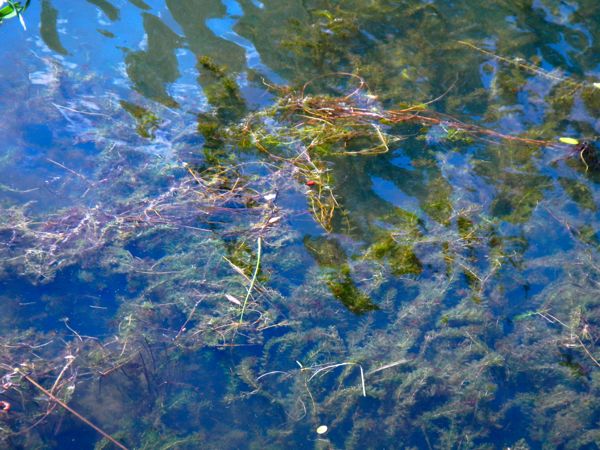Trying to stop spread of non-native species
By Linda Fine Conaboy
INCLINE VILLAGE – There are always chores to take care of before launching boats, kayaks, paddleboards and all the other warm-weather stuff at Lake Tahoe, but there’s one more job to take care of that’s just as important as tuning up the gear.
Now’s the time to have everything inspected for the critters and weeds that may have wintered over—and that includes even the water wings.
Although any invasive varmints or weeds that spent the winter in storage attached to a rudder are probably dead and not capable of harming the lake (but they can survive up to 30 days), this is the time of year to clean up the gear and get it inspected before launching.
Zack Bradford, natural resources manager for the League to Save Lake Tahoe, was one of several speakers at the spring public forum June 14 at the Tahoe Center for Environmental Sciences at Sierra Nevada College, hosted jointly by Tahoe Regional Planning Agency, the League and Tahoe Resource Conservation District.

The Tahoe Keys is home to the bulk of the milfoil at Lake Tahoe. Photo/LTN file
Bradford described the various intruders into the lake’s environment, including warm water fish, clams, Eurasian watermilfoil and curly pondweed, all of which have felt the full force of those driven to eradicate them before they can cause more damage.
Eurasian watermilfoil’s introduction into U.S. waters happened sometime between the 1880s and the 1940s, possibly through the aquarium trade or the transport of watercraft. It crowds out “good” plants, the native species, sucking oxygen out of the water, and is now spreading from Tahoe’s South Shore to other parts of the lake.
Curly pondweed, a lesser-known plant, is able to survive in open, more turbulent water as opposed to milfoil’s preferred environment, quiet lagoons such as Tahoe Keys.
Even a small piece of an unwanted plant found floating in open water is capable of creating another intrusion, said Rick Lind, a consultant for the Tahoe Keys Property Owners Association.
“Ninety percent of the Keys is infested with unwanted plants. The current methods have not been working,” Lind said. However, he listed other techniques that have been implemented that are helping to alleviate the problem.
They include: harvesting, water conservation, banning phosphorus-based fertilizers, turf conversion from grass to natural landscaping, bottom barriers, dog waste stations at convenient locations, homeowner education and labeling and monitoring all storm drains.
“With 1,500 home and 900 docks, a solution must happen,” he said.
To add to the woes, non-native warm water fish such as largemouth bass and bluegill have made their way to Tahoe’s waters.
Why care if these fish are happily integrating into the pristine lake?
According to the UNR’s College of Agriculture, they are breeding close to the shoreline in areas where native hatchlings live and grow. And because of the proliferation of invasive weeds and climate change warming the lake’s waters, they are able to thrive, preying on non-native crayfish among other tasty food sources.
UNR’s website said that warm water fish have been detected at 58 percent of the 16 locations monitored in various sites around the lake, leading to a continuing decline of native fish.
Although these aquatic invasive species are not exactly reeling from the full frontal attack, efforts to control them are beginning to pay off.
Nicole Cartwright, AIS program coordinator for Tahoe RCD, an organization supporting all aspects of conservation issues, said that although quagga mussels have invaded Southern Nevada’s Lake Mead, they have yet to find their way to Tahoe. She credits the diligence of the boat inspection program for keeping quaggas away as well as zebra mussels, also found in Lake Mead and other bodies of water.
In addition to Tahoe, boats launching at Echo and Fallen Leaf lakes are inspected.
“The program is proven; early detection is vital.” Cartwright said. “There have been no new detections since it started. The fee charged has caused people to stay clean. Tahoe is helping to change Western boating habits.”
Cartwright said since 2008, more than 50,000 watercraft have been inspected and 20,000 have been decontaminated using extremely hot water. She said the fees for inspection and possible decontamination vary according to boat size, although non-motorized craft, if they need inspection, are free.
She added that normally non-motorized craft don’t need to be checked, unless they’ve recently been in suspect waters.
“With clams and weeds, the implementation programs are helping to cure the problem,” Cartwright said, adding that slowly they are also getting the jump on warm water fish, with more than 9,000 of them electroshocked last year.
“We have a mechanism for management. We’re not exactly winning now, but we’re keeping them at bay and staying ahead of the game.”
The use of herbicides to eliminate invasive weeds was discussed at the forum, causing an outcry from some members of the audience who wondered why potential poisons need to be a part of the toolbox.
“Herbicides are a difficult topic for a lot of folks,” Cartwright said. “But we’re still in the analysis phase. We’re evaluating the effectiveness of herbicides as a potential method to kill plants, but it’s not been approved by regulatory agencies. We won’t know for another five years if it will be approved.”
The forum’s speakers all touted the implementation of various programs, which invite public participation, such as Eyes on the Lake, Tahoe Keepers, the Pipe Keepers programs and the Lake Tahoe citizens science app as effective methods to help in the invasion battle.
All of these programs are designed to engage citizens to care for the lake by keeping their eyes and ears open to new plant growths or other egregious encroachments by reporting what they find.
For more information on all of these subjects is available online.


